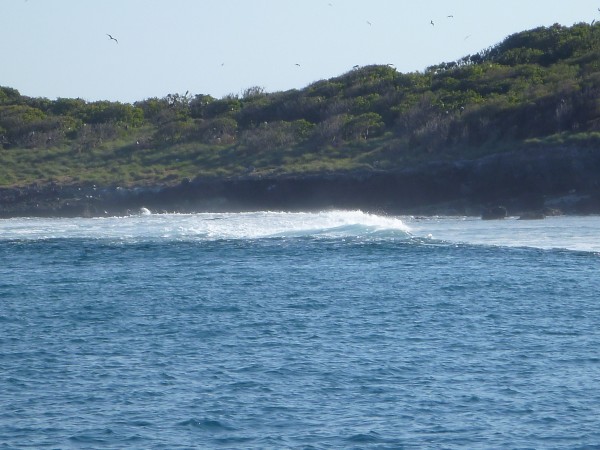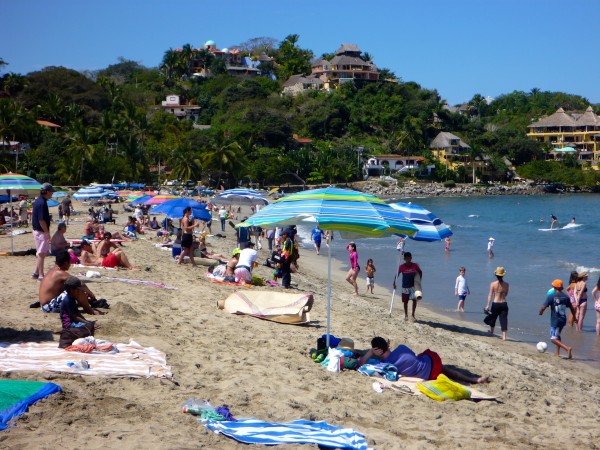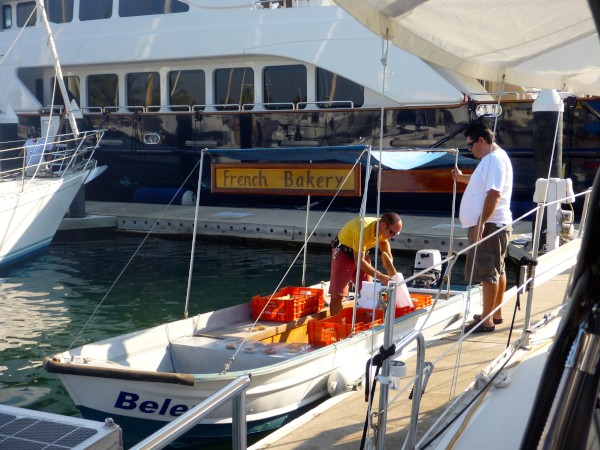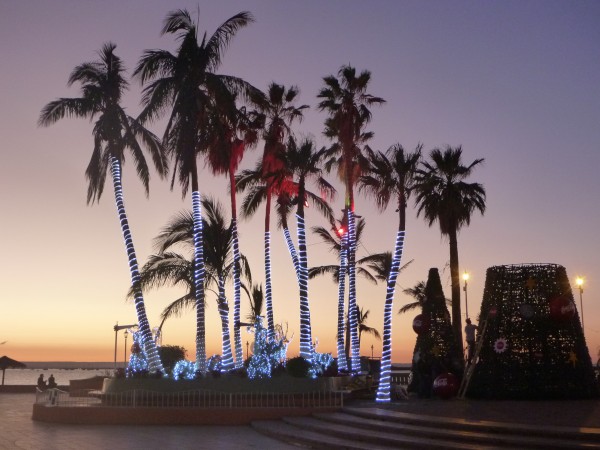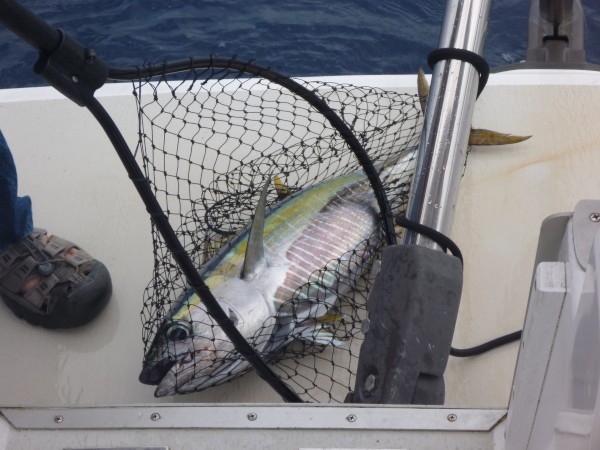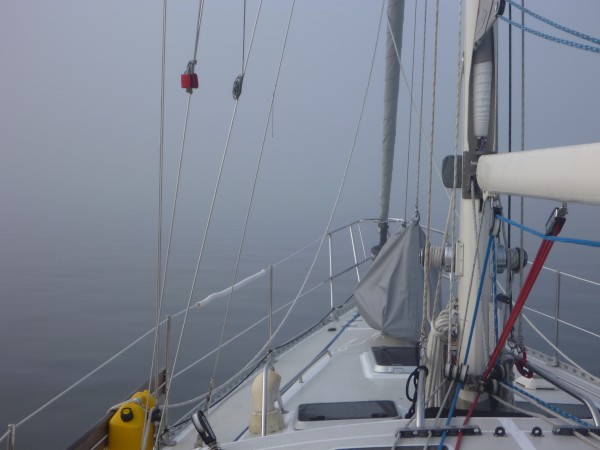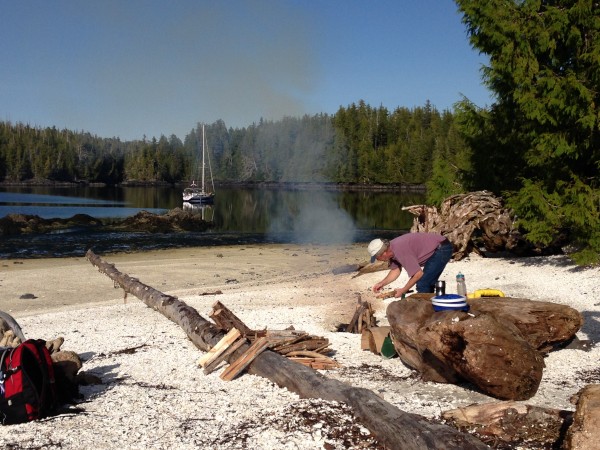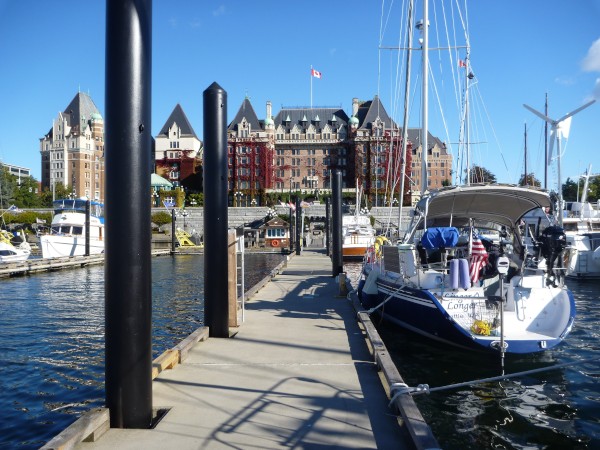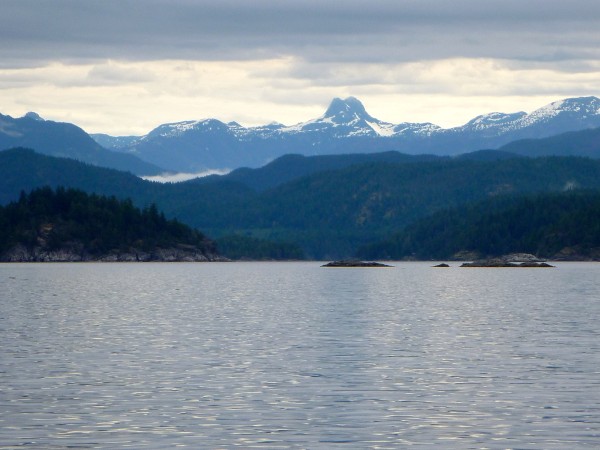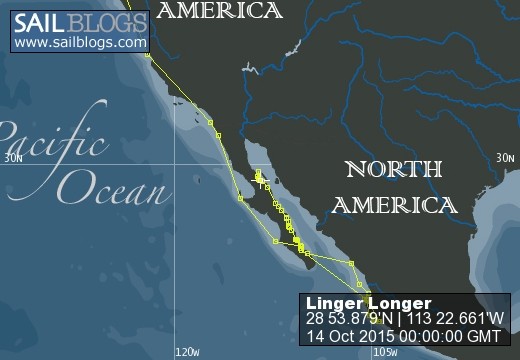
Linger Longer
14 September 2016
06 August 2016
09 July 2016
19 March 2016
19 December 2015
18 December 2015
18 December 2015
03 November 2015
18 July 2015
24 May 2015
04 April 2015
31 March 2015
26 February 2015
15 February 2015 | Barra de Navidad
07 February 2015 | Tenacatita Bay
04 February 2015
26 January 2015 | 19 18.051'N
04 January 2015 | La Cruz, Nayarit, Mexico
25 December 2014 | La Paz, Baja California Sur, Mexico
01 December 2014 | Ensenada, Mexico
Reflections by Kirk
14 September 2016
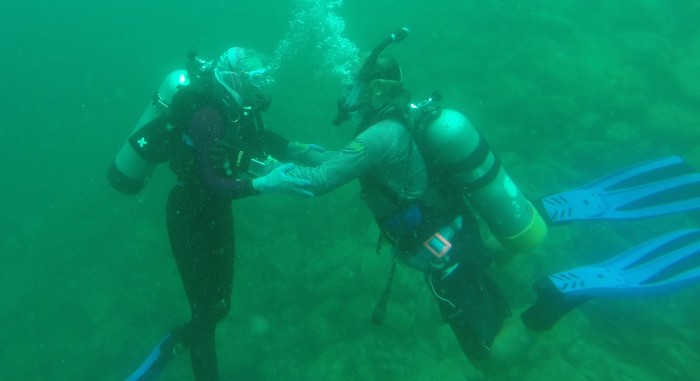
Summer is drawing to a close. It has been an unusually nice summer up here in the Bahia de Los Angeles area in the northern part of the Sea of Cortez. Air and water temperatures have been at least five degrees cooler than last year. Thunder and lightning storms, known down here as chubascos, have occurred with much less frequency than last year. We had a close brush with a hurricane. Newton passed about 80 miles away last week, but we had only moderately stronger winds than is normal and maybe one-quarter inch of rain. So far so good, but the hurricane season officially lasts for about another seven weeks. We are currently waiting to see what will happen with a new tropical disturbance that preliminary forecasts give a chance of coming in contact with the Baja Peninsula.
Prior to Newton, rainfall has been non-existent on the Baja Peninsula for about one year. We have heard reports that farmers and ranchers experienced very difficult times. Cattle have been dying for lack of water and there was not much on which to graze. Even goats, which are very durable animals, have had problems. Feed prices have been much too high for the poor ranchers to buy much of. We hope that the heavy rains in the southern portion of the Baja from hurricane Newton will help. On the other hand, coyotes and rabbits seem to be getting along very well. We often see coyotes roaming beaches and hear them yipping away at night. Walks just a short way away from the beach reveal lots of rabbit tracks through the desert although we do not see them often.
The lack of rainfall has had another consequence for us cruisers. Bees seem to be at nearly every anchorage in relatively high numbers. We know that, like livestock, they are also desperate for fresh water, and cruising boats are always a likely source. When we enter a new anchorage, one or a few scouts come almost immediately to check us out. We hear the same from all of the other cruisers up here. On Linger Longer, we have put bee attenuation procedures in place. Screens go up on all open windows and hatches, so the bees cannot get inside. The back of our boat has a swim step, a small platform just above the water. There is a locker built into the transom that holds our propane tanks as well as a faucet with a long hose and a wand on the end so that we can rinse off or shower on the swim step. This turns out to be the biggest problem for us in bee control. Propane is heavier than air and so any fumes settle to the bottom of the locker. We have vents in the bottom allowing any propane fumes to drift out, mix with the outside air and dilute enough to eliminate any hazard. Because this locker also has a faucet, there is almost always a bit of residual water in the locker. The dilemma is how to screen off the vent opening to prevent bees from getting in, but still allow propane fumes to vent. We played around with different materials and finally found one that seems to work and we taped it in place. The scout bees still come to check us out, but when they find that there is no way to get fresh water, they do not send out the “come and get it” signal to the rest of the hive. One time the tape came off the vent screen in the propane locker. Bees could get into the locker and the tiny bit of fresh water that was lying in the bottom from our faucet. By the time we woke up and went out into the cockpit one morning, scores of bees were swarming all over the place, effectively confining us to stay below deck until nighttime when they finally went away. We fixed that before the next AM and now check the tape regularly.
When we first came up here last year, we did not understand the bee problem, but learned pretty quickly. There were no screens up and we went off in the dinghy to explore. Upon our return we found that bees had taken over the boat. The faucets in the galley (kitchen) and in the head (bathroom) attracted swarms of bees. There are some of those spiraling mosquito coils on the boat; and since Kris knows where they are stowed, I volunteered her to go down below and light one. She did and the bees, for the most part went away. We do not have the little screens in our faucets and the first time we used water about ten bees flew out of it. Surprise! Even though we now have reasonably good precautions in place, we still get stung occasionally. Kris has an excellent remedy. There is a small bush in the Baja called Creosote Bush. She will snip several small branches, strip the leaves and put them in a bottle with plain old rubbing alcohol. About a week later, it is strained and we end up with a brown tincture. After a bee sting, we remove the stinger and rub some of this liquid over the sting site and residual effects of the sting just go away. We have been told that this indigenous remedy is an analgesic as well as an antiseptic. It works. We know that the bees are just trying to get water to stay alive and that bees are an important part of the whole cycle of life, but sometimes it still seems like we are in a war. When there were just a few scouts, we would sometimes go after them with an electronic flyswatter in the hopes that word would get back to the hive that our boat was a bad place to go searching for water. The flyswatter finally died, so sometimes we flap a cloth around to make them go away. This morning I came up with yet another way to kill a bee. I inadvertently squashed one in my armpit. This was a very effective way to kill a bee, but the resultant sting makes me think there must be a better strategy.
Another boat, that is up here with us had an unusual wildlife encounter. They were peacefully at anchor and the lady was in the cockpit cooking dinner on a camp stove. Sailboat cockpits are not always very large spaces and theirs is no exception. They also have a cockpit drain that is a three-inch pipe leading through the hull and drains just above the waterline. After slaving away over the stove for about half an hour, the lady went below for a bit and her husband came out into the cockpit. He noticed that there was a beautifully colored shape just behind a board leaning against a wall about eight inches from where the cook had been standing. The shape moved and he realized he was looking at a diamondback rattlesnake. From the way they tell the story, the hysteria was mostly contained and the screams were not even heard by a boat anchored nearby. Eventually, calm prevailed and a boathook was fetched from the foredeck. After several minutes of the man trying to lift the snake with the boathook and the snake trying just as hard not to be lifted, the snake ended up in the water. The diamondback knew a good thing and immediately swam back to the cockpit drain and re-entered the cockpit. Another boathook versus snake battle ensued with the snake once again deposited into the water. The man knew what was coming next and tried to keep the snake away from the cockpit drain. Only the snake was also learning and wrapped itself around the boathook in the hope of being lifted back onto the boat instead of having to slither its way back up the drain. The human brain prevailed, with the result that the snake was flung many yards away from the boat and gave up. It just curled up in the standard rattlesnake pose and floated around with its head just a few inches above the water. It stayed just like that until it drifted out of sight with the current. We all know that rattlesnakes are a part of the desert landscape, but we are told that encounters are rare as the snakes usually move away before we even know they are around. None of us ever even considered the idea that rattlesnakes would swim through water much less salt water. It is said that you should endeavor to learn at least one new thing every day. So now we can add rattlesnakes to sharks, jellyfish, crocodiles and other wonders of nature to the list of dangerous things in the waters of coastal Mexico.
While on the subject of unusual wildlife, there are two other bugs of interest. The first is what I call a “bat moth” although we have been told it is more properly called a “black witch moth.” These things are huge, with maybe an eight-inch wingspan and are very darkly colored. The first time I saw one on our boat, it was sitting on the edge of a closed drawer. I got a quick glance at it when I bent over to pick up something I dropped. My head was upside down and the legs of our salon table obscured my view a bit, so I did not believe what my eyes told me. The second glance convinced me that we did indeed have a bat inside the boat. The third, longer glance revealed soft wings and I was then a little less batty. I scooped him outside with a baseball cap. The next time we saw one was at night while enjoying “sundowners” with some friends in our cockpit. One of the ladies started making strange noises and flapping her arms. When we turned to look, all we could see was this giant thing flying out from between her legs. It may take some time before the story of this woman spawning a bat will be forgotten.
A less pleasant bug is known down here as a jejene, also known as no-see-ums up north. These are miserable creatures. They are too small for normal screens to keep them outside the boat and they really are almost too small to see. The bite can sometimes be felt and sometimes not, but the results are rotten. By the next day they itch like crazy and the “welt” seems to last and be continually annoying for weeks. This may be my absolute least favorite creature in the world. They are not everywhere, but if they turn up where we are at, we will be leaving sooner rather than lingering about. We do not go places where people say jejenes are around.
Kris and I recently had an excellent new-for-us experience. We have the very good fortune to know two of the most preeminent scuba divers in the Sea of Cortez. Decades of experience and a love of sharing their passion with others resulted in our first ever scuba diving adventure. We have been snorkeling, but for us snorkeling is floating along the surface of the water and looking through facemasks at the scenery below. And the scenery is quite extraordinary. Up here in the Baja when we look around from the security of the cockpit we see a desert. Granted the desert can, in its way, be quite beautiful especially early in the morning or late in the afternoon when the sunlight is different and brings the many colors of the landscape to life. We have seen thousands of square miles of the ocean’s surface, often wondering what is going on below that we cannot see. Snorkeling has allowed us to see some of the underwater landscape, but the water clarity is not always good and we only see what is in the shallows. That can be awesome. Since these waters are tropical, we see lots of fish that I had only seen previously in fish tanks. We can see schools of fish that we sometimes have for dinner. We can watch the interaction of the fish with one another. Snorkeling has been and I am certain will continue to be a big part of our cruising experience, but scuba adds a whole new dimension. We can go down to depths that we cannot do with the snorkels. The sights are similar, but different. Seems to be bigger fish at greater depths. We can get close to the rocks and see all of the activity that goes on in the crevices and spaces between rocks. There is more variety of corals and plant life. Breathing underwater allows us to feel a bit like the fish we are swimming with. Face-to-fish encounters are not unusual. We look up and see fish swim above us, similar, but different than being at high places up in the northwest and seeing Eagles flying below. Our friends cut open some scallops and we were able to feed puffer fish. They ate right out of our hands. We hope to have more chances to experience scuba, especially with our friends. They have complete extra sets of tanks, regulators and enough of what is needed for us to dive with them and they really want other folks to experience their passion. Sometimes I cannot believe how lucky I am. It is now easy to see why so many people are addicted to entering the underwater world. I suppose it is unlikely that we will outfit ourselves to be in a position to go diving whenever we want to. I have no idea of the expense involved in acquiring the diving gear, the air compressor and a generator to run the compressor, but expect that it is significant. An even bigger problem for us would be the ability to stow all of that additional gear on the boat. But you never know for sure what the future holds. Scuba most assuredly adds a whole new and wonderful facet to the cruising experience in addition to also adding an element of safety. Scuba would allow us to inspect how well our anchor is set and see what hazards may occupy the bottom of the anchorage as well as the bottom of our boat. In any event, the experience was awesome.
We will be watching the weather very carefully and begin the trip back south where there is once again cell coverage and internet access. Not sure when we will actually be leaving Bahia de Los Angeles, but we are committed to be back in Banderas Bay (Puerto Vallarta) in time to make a trip out of the country to renew our visas and then return to spend time with friends who are coming down from Seattle in early December. Schedules are maybe the biggest dangers to cruisers, so we will be heading that way trying to allow plenty of time for the unforeseen things that always seem to happen.
Life is Good.
Kirk
S/V Linger Longer
Postscript - Since writing this, we have completed our second dive and are preparing for the third one today, 09/14/16.
Prior to Newton, rainfall has been non-existent on the Baja Peninsula for about one year. We have heard reports that farmers and ranchers experienced very difficult times. Cattle have been dying for lack of water and there was not much on which to graze. Even goats, which are very durable animals, have had problems. Feed prices have been much too high for the poor ranchers to buy much of. We hope that the heavy rains in the southern portion of the Baja from hurricane Newton will help. On the other hand, coyotes and rabbits seem to be getting along very well. We often see coyotes roaming beaches and hear them yipping away at night. Walks just a short way away from the beach reveal lots of rabbit tracks through the desert although we do not see them often.
The lack of rainfall has had another consequence for us cruisers. Bees seem to be at nearly every anchorage in relatively high numbers. We know that, like livestock, they are also desperate for fresh water, and cruising boats are always a likely source. When we enter a new anchorage, one or a few scouts come almost immediately to check us out. We hear the same from all of the other cruisers up here. On Linger Longer, we have put bee attenuation procedures in place. Screens go up on all open windows and hatches, so the bees cannot get inside. The back of our boat has a swim step, a small platform just above the water. There is a locker built into the transom that holds our propane tanks as well as a faucet with a long hose and a wand on the end so that we can rinse off or shower on the swim step. This turns out to be the biggest problem for us in bee control. Propane is heavier than air and so any fumes settle to the bottom of the locker. We have vents in the bottom allowing any propane fumes to drift out, mix with the outside air and dilute enough to eliminate any hazard. Because this locker also has a faucet, there is almost always a bit of residual water in the locker. The dilemma is how to screen off the vent opening to prevent bees from getting in, but still allow propane fumes to vent. We played around with different materials and finally found one that seems to work and we taped it in place. The scout bees still come to check us out, but when they find that there is no way to get fresh water, they do not send out the “come and get it” signal to the rest of the hive. One time the tape came off the vent screen in the propane locker. Bees could get into the locker and the tiny bit of fresh water that was lying in the bottom from our faucet. By the time we woke up and went out into the cockpit one morning, scores of bees were swarming all over the place, effectively confining us to stay below deck until nighttime when they finally went away. We fixed that before the next AM and now check the tape regularly.
When we first came up here last year, we did not understand the bee problem, but learned pretty quickly. There were no screens up and we went off in the dinghy to explore. Upon our return we found that bees had taken over the boat. The faucets in the galley (kitchen) and in the head (bathroom) attracted swarms of bees. There are some of those spiraling mosquito coils on the boat; and since Kris knows where they are stowed, I volunteered her to go down below and light one. She did and the bees, for the most part went away. We do not have the little screens in our faucets and the first time we used water about ten bees flew out of it. Surprise! Even though we now have reasonably good precautions in place, we still get stung occasionally. Kris has an excellent remedy. There is a small bush in the Baja called Creosote Bush. She will snip several small branches, strip the leaves and put them in a bottle with plain old rubbing alcohol. About a week later, it is strained and we end up with a brown tincture. After a bee sting, we remove the stinger and rub some of this liquid over the sting site and residual effects of the sting just go away. We have been told that this indigenous remedy is an analgesic as well as an antiseptic. It works. We know that the bees are just trying to get water to stay alive and that bees are an important part of the whole cycle of life, but sometimes it still seems like we are in a war. When there were just a few scouts, we would sometimes go after them with an electronic flyswatter in the hopes that word would get back to the hive that our boat was a bad place to go searching for water. The flyswatter finally died, so sometimes we flap a cloth around to make them go away. This morning I came up with yet another way to kill a bee. I inadvertently squashed one in my armpit. This was a very effective way to kill a bee, but the resultant sting makes me think there must be a better strategy.
Another boat, that is up here with us had an unusual wildlife encounter. They were peacefully at anchor and the lady was in the cockpit cooking dinner on a camp stove. Sailboat cockpits are not always very large spaces and theirs is no exception. They also have a cockpit drain that is a three-inch pipe leading through the hull and drains just above the waterline. After slaving away over the stove for about half an hour, the lady went below for a bit and her husband came out into the cockpit. He noticed that there was a beautifully colored shape just behind a board leaning against a wall about eight inches from where the cook had been standing. The shape moved and he realized he was looking at a diamondback rattlesnake. From the way they tell the story, the hysteria was mostly contained and the screams were not even heard by a boat anchored nearby. Eventually, calm prevailed and a boathook was fetched from the foredeck. After several minutes of the man trying to lift the snake with the boathook and the snake trying just as hard not to be lifted, the snake ended up in the water. The diamondback knew a good thing and immediately swam back to the cockpit drain and re-entered the cockpit. Another boathook versus snake battle ensued with the snake once again deposited into the water. The man knew what was coming next and tried to keep the snake away from the cockpit drain. Only the snake was also learning and wrapped itself around the boathook in the hope of being lifted back onto the boat instead of having to slither its way back up the drain. The human brain prevailed, with the result that the snake was flung many yards away from the boat and gave up. It just curled up in the standard rattlesnake pose and floated around with its head just a few inches above the water. It stayed just like that until it drifted out of sight with the current. We all know that rattlesnakes are a part of the desert landscape, but we are told that encounters are rare as the snakes usually move away before we even know they are around. None of us ever even considered the idea that rattlesnakes would swim through water much less salt water. It is said that you should endeavor to learn at least one new thing every day. So now we can add rattlesnakes to sharks, jellyfish, crocodiles and other wonders of nature to the list of dangerous things in the waters of coastal Mexico.
While on the subject of unusual wildlife, there are two other bugs of interest. The first is what I call a “bat moth” although we have been told it is more properly called a “black witch moth.” These things are huge, with maybe an eight-inch wingspan and are very darkly colored. The first time I saw one on our boat, it was sitting on the edge of a closed drawer. I got a quick glance at it when I bent over to pick up something I dropped. My head was upside down and the legs of our salon table obscured my view a bit, so I did not believe what my eyes told me. The second glance convinced me that we did indeed have a bat inside the boat. The third, longer glance revealed soft wings and I was then a little less batty. I scooped him outside with a baseball cap. The next time we saw one was at night while enjoying “sundowners” with some friends in our cockpit. One of the ladies started making strange noises and flapping her arms. When we turned to look, all we could see was this giant thing flying out from between her legs. It may take some time before the story of this woman spawning a bat will be forgotten.
A less pleasant bug is known down here as a jejene, also known as no-see-ums up north. These are miserable creatures. They are too small for normal screens to keep them outside the boat and they really are almost too small to see. The bite can sometimes be felt and sometimes not, but the results are rotten. By the next day they itch like crazy and the “welt” seems to last and be continually annoying for weeks. This may be my absolute least favorite creature in the world. They are not everywhere, but if they turn up where we are at, we will be leaving sooner rather than lingering about. We do not go places where people say jejenes are around.
Kris and I recently had an excellent new-for-us experience. We have the very good fortune to know two of the most preeminent scuba divers in the Sea of Cortez. Decades of experience and a love of sharing their passion with others resulted in our first ever scuba diving adventure. We have been snorkeling, but for us snorkeling is floating along the surface of the water and looking through facemasks at the scenery below. And the scenery is quite extraordinary. Up here in the Baja when we look around from the security of the cockpit we see a desert. Granted the desert can, in its way, be quite beautiful especially early in the morning or late in the afternoon when the sunlight is different and brings the many colors of the landscape to life. We have seen thousands of square miles of the ocean’s surface, often wondering what is going on below that we cannot see. Snorkeling has allowed us to see some of the underwater landscape, but the water clarity is not always good and we only see what is in the shallows. That can be awesome. Since these waters are tropical, we see lots of fish that I had only seen previously in fish tanks. We can see schools of fish that we sometimes have for dinner. We can watch the interaction of the fish with one another. Snorkeling has been and I am certain will continue to be a big part of our cruising experience, but scuba adds a whole new dimension. We can go down to depths that we cannot do with the snorkels. The sights are similar, but different. Seems to be bigger fish at greater depths. We can get close to the rocks and see all of the activity that goes on in the crevices and spaces between rocks. There is more variety of corals and plant life. Breathing underwater allows us to feel a bit like the fish we are swimming with. Face-to-fish encounters are not unusual. We look up and see fish swim above us, similar, but different than being at high places up in the northwest and seeing Eagles flying below. Our friends cut open some scallops and we were able to feed puffer fish. They ate right out of our hands. We hope to have more chances to experience scuba, especially with our friends. They have complete extra sets of tanks, regulators and enough of what is needed for us to dive with them and they really want other folks to experience their passion. Sometimes I cannot believe how lucky I am. It is now easy to see why so many people are addicted to entering the underwater world. I suppose it is unlikely that we will outfit ourselves to be in a position to go diving whenever we want to. I have no idea of the expense involved in acquiring the diving gear, the air compressor and a generator to run the compressor, but expect that it is significant. An even bigger problem for us would be the ability to stow all of that additional gear on the boat. But you never know for sure what the future holds. Scuba most assuredly adds a whole new and wonderful facet to the cruising experience in addition to also adding an element of safety. Scuba would allow us to inspect how well our anchor is set and see what hazards may occupy the bottom of the anchorage as well as the bottom of our boat. In any event, the experience was awesome.
We will be watching the weather very carefully and begin the trip back south where there is once again cell coverage and internet access. Not sure when we will actually be leaving Bahia de Los Angeles, but we are committed to be back in Banderas Bay (Puerto Vallarta) in time to make a trip out of the country to renew our visas and then return to spend time with friends who are coming down from Seattle in early December. Schedules are maybe the biggest dangers to cruisers, so we will be heading that way trying to allow plenty of time for the unforeseen things that always seem to happen.
Life is Good.
Kirk
S/V Linger Longer
Postscript - Since writing this, we have completed our second dive and are preparing for the third one today, 09/14/16.
Comments
| Vessel Name: | S/V Linger Longer |
| Vessel Make/Model: | Sceptre 41/43 |
| Hailing Port: | Seattle, WA |
| Crew: | Kirk & Kristin Doyle |
| Extra: | |
| Home Page: | http://www.k2doyle.com |
S/V Linger Longer's Photos - Main
|
Heading north into the Sea of Cortez for the summer where there is less change of hurricanes.
72 Photos
Created 19 December 2015
|
Who: Kirk & Kristin Doyle
Port: Seattle, WA
